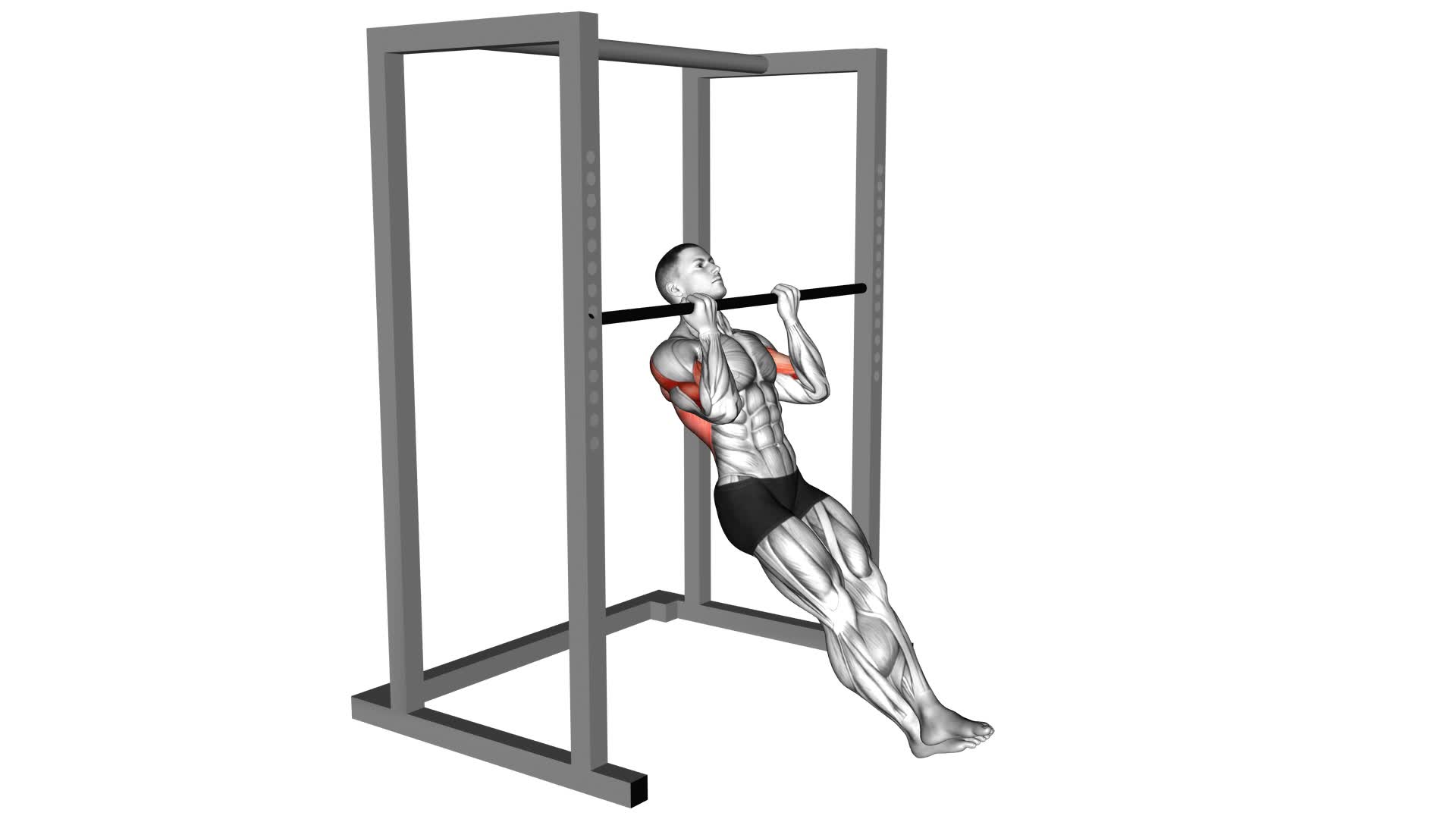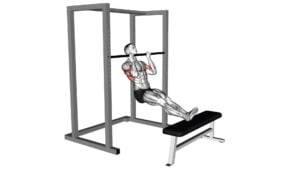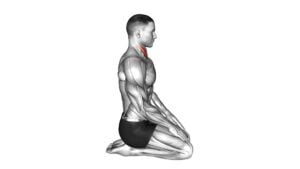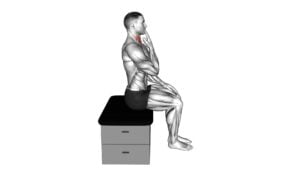Seated Chin-up – Video Exercise Guide & Tips

Are you looking to strengthen your upper body and improve your overall fitness?
Watch This Exercise Video
The seated chin-up is the perfect exercise for you. In this video exercise guide, we'll show you the proper technique and give you valuable tips to maximize your results.
With just a few minutes a day, you can make significant progress and achieve your fitness goals. So grab a chair and get ready to take your workout to the next level with the seated chin-up.
Key Takeaways
- Seated chin-up improves upper body strength and muscle definition.
- It targets back, biceps, and shoulders.
- Seated chin-up enhances grip strength.
- It improves posture and reduces the risk of back pain.
Benefits of the Seated Chin-up
If you incorporate seated chin-ups into your workout routine, you can expect significant improvements in your upper body strength and muscle definition. Seated chin-ups are a versatile exercise that offer various modifications and grip variations to target different muscle groups and cater to different fitness levels.
One of the benefits of seated chin-ups is the ability to modify the exercise to suit your specific needs. For beginners or individuals with limited upper body strength, using a resistance band can provide assistance by reducing the amount of weight you have to lift. On the other hand, if you're looking for a challenge, adding weights or using a weighted vest can increase the intensity of the exercise.
In addition to modifications, there are also different grip variations that can be used during seated chin-ups. The standard chin-up grip, also known as supine grip, focuses on the biceps and upper back muscles. Switching to a neutral grip, where your palms face each other, shifts the emphasis to the forearms and brachialis muscles. Lastly, an underhand grip, also known as reverse grip, targets the biceps and lower back muscles.
Incorporating seated chin-ups into your workout routine can provide a range of benefits, including increased upper body strength, improved muscle definition, and the ability to target different muscle groups through modifications and grip variations. Whether you're a beginner or an experienced fitness enthusiast, seated chin-ups offer a challenging and effective exercise for achieving your fitness goals.
Equipment Needed for the Seated Chin-up
To perform the seated chin-up, you'll need a sturdy chin-up bar and a secure seat or bench. The chin-up bar should be able to support your body weight without any risk of breaking or coming loose. Look for a bar that's specifically designed for chin-ups and is securely anchored to the wall or ceiling. Make sure the seat or bench is stable and can comfortably support your weight throughout the exercise.
When it comes to variations and modifications of the seated chin-up, there are a few options to consider. One variation is the assisted seated chin-up, where you use a resistance band or a machine to help support some of your body weight. This can be helpful for beginners or those who are working on building strength. Another modification is the weighted seated chin-up, where you add weight to increase the intensity of the exercise. This can be done by wearing a weighted vest or holding a dumbbell between your feet.
Now that you know what equipment is needed for the seated chin-up, let's move on to discussing the proper technique for this exercise.
Proper Technique for the Seated Chin-up
To perform the seated chin-up with proper technique, it's important to consider the different grip variations available. By changing your grip, you can target different muscles and add variety to your workout.
Additionally, it's crucial to avoid common mistakes such as using momentum or relying solely on your biceps.
Grip Variations for Chin-Ups
Choose from various grip variations to perform the seated chin-up with proper technique. The grip you use during a chin-up can have a significant impact on your grip strength and muscle activation. By changing your grip, you can target different muscle groups and increase the intensity of the exercise.
The most common grip variations for chin-ups include the underhand supine grip, overhand pronated grip, and the neutral grip. The underhand supine grip, also known as the chin-up grip, places more emphasis on the biceps and upper back muscles. The overhand pronated grip, or pull-up grip, targets the lats, shoulders, and upper back. The neutral grip, where your palms face each other, engages the biceps, forearms, and back muscles.
Experiment with different grips to find the one that challenges you the most and provides optimal muscle activation.
Common Mistakes to Avoid
To perform the seated chin-up with proper technique and avoid common mistakes, you should focus on maintaining a strong grip and engaging the correct muscle groups. Here are some tips for success:
- Avoid using momentum: Instead of swinging your body or using your legs to assist in the movement, rely solely on your upper body strength to lift yourself up.
- Keep your core engaged: Tighten your abdominal muscles throughout the exercise to provide stability and prevent any excessive arching or rounding of the back.
- Don't neglect your shoulder blades: Retract and depress your shoulder blades before initiating the movement to activate the correct muscles and ensure proper alignment.
- Control the descent: Lower yourself down in a slow and controlled manner, resisting the urge to simply drop down.
- Use an appropriate grip width: Find a grip that's comfortable for you, ensuring that your hands are slightly wider than shoulder-width apart.
By following these tips, you can avoid common mistakes and perform the seated chin-up with proper technique.
Now, let's explore the next section on the common mistakes to avoid during the seated chin-up.
Common Mistakes to Avoid During the Seated Chin-Up
Avoid these common mistakes when performing the seated chin-up exercise.
While the seated chin-up is a great exercise for targeting the muscles in your back, arms, and shoulders, it's important to ensure you're performing it correctly to maximize its benefits and prevent injury.
One common mistake is using momentum to lift yourself up. Instead, focus on using your back and arm muscles to initiate the movement. This will help to strengthen and engage the targeted muscles effectively.
Another mistake to avoid is hunching your shoulders or rounding your back during the exercise. This can put unnecessary stress on your spine and decrease the effectiveness of the exercise. Keep your shoulders pulled back and down, and maintain a straight back throughout the movement.
It's also important to avoid relying on your biceps to perform the exercise. The seated chin-up primarily targets the muscles in your back, so make sure you're using proper form and engaging your back muscles to lift yourself up.
Lastly, avoid performing the exercise with improper modifications or advanced variations without proper progression. Start with the basic seated chin-up and gradually increase the difficulty as your strength improves.
Modifications and Advanced Variations for the Seated Chin-up
To challenge yourself further and enhance your seated chin-up routine, explore modifications and advanced variations. Here are some modifications for beginners and advanced grip variations that you can try:
- Assisted Chin-ups: If you're just starting out or struggling with the exercise, you can use an assisted chin-up machine or resistance bands to lighten the load and gradually build strength.
- Negative Chin-ups: Start at the top of the chin-up position and slowly lower yourself down, focusing on the eccentric phase of the movement. This helps build strength and control.
- Wide Grip Chin-ups: Instead of using a shoulder-width grip, try placing your hands wider apart on the bar. This variation emphasizes the muscles in your back and shoulders.
- Close Grip Chin-ups: Bring your hands closer together on the bar, slightly narrower than shoulder-width. This variation targets your biceps and forearms more intensely.
- Mixed Grip Chin-ups: Use an underhand grip with one hand and an overhand grip with the other. This grip variation helps you lift more weight and engage different muscles.
By incorporating these modifications and advanced grip variations into your seated chin-up routine, you can continue challenging your muscles, improving strength, and achieving your fitness goals.
Remember to listen to your body, start with modifications if needed, and gradually progress to advanced variations.
Tips for Incorporating the Seated Chin-Up Into Your Fitness Routine
To effectively incorporate the seated chin-up into your fitness routine, there are a few key points to keep in mind.
First, if you're a beginner, start with variations that suit your current strength level to avoid injury.
Second, focus on maintaining proper form and technique throughout the exercise, including a controlled and smooth movement.
Lastly, remember that the seated chin-up offers numerous benefits, such as strengthening your upper back, shoulders, and arms, as well as improving grip strength.
Variations for Beginners
What are some ways you can incorporate the seated chin-up into your fitness routine if you're a beginner? Here are some beginner modifications and progressions you can try:
- Assisted Chin-ups: Use a resistance band or an assisted chin-up machine to help support your weight and make the exercise more manageable.
- Negative Chin-ups: Start in the top position of the chin-up and slowly lower yourself down, focusing on the eccentric portion of the movement.
- Chair Chin-ups: Place a chair underneath the chin-up bar and use your legs to push off and assist you in completing the exercise.
- Band-assisted Chin-ups: Attach a resistance band to the chin-up bar and loop it around your feet or knees to provide assistance as you pull yourself up.
- Flexed-arm Hangs: Start by simply hanging from the bar with your chin above it, focusing on building your grip strength and upper body stability.
Proper Form and Technique
When incorporating the seated chin-up into your fitness routine, focus on maintaining proper form and technique. This will help you maximize the benefits of the exercise while minimizing the risk of injury. One common mistake to avoid is using momentum to swing yourself up instead of relying on your upper body strength. Make sure to keep your back straight, engage your core, and pull yourself up using your arms and shoulders.
Another important aspect is grip variations. Experiment with different hand positions, such as a wide grip or a narrow grip, to target different muscles in your upper body.
By incorporating proper form and technique, you can ensure that you're getting the most out of your seated chin-up exercise.
Now, let's explore the benefits of incorporating this exercise into your fitness routine.
Benefits of Seated Chin-Up
To incorporate the seated chin-up into your fitness routine, you can reap numerous benefits by targeting multiple upper body muscles and improving your overall strength and stability. Here are some benefits of incorporating the seated chin-up into your workout:
- Increased upper body strength: The seated chin-up primarily targets your back, biceps, and shoulders, helping you develop strength in these areas.
- Improved grip strength: Holding onto the bar during the chin-up requires a strong grip, which can benefit your performance in other exercises and daily activities.
- Enhanced posture: The seated chin-up helps strengthen your upper back muscles, helping to improve your posture and reduce the risk of back pain.
- Increased muscle definition: Regularly performing seated chin-ups can help build and define your back, biceps, and shoulders, giving you a more sculpted upper body.
- Versatility: The seated chin-up can be modified by adjusting the grip width, adding resistance bands, or using additional weights for more advanced variations.
Incorporating seated chin-ups into your fitness routine can provide a challenging and effective way to strengthen your upper body and improve overall fitness.
Frequently Asked Questions
How Many Calories Does the Seated Chin-Up Burn?
Seated chin-ups are a great exercise for burning calories and building upper body strength. As a beginner, it's important to start with proper form and gradually increase the number of reps.
While the exact number of calories burned during a seated chin-up can vary depending on factors like weight and intensity, it's generally considered an effective calorie-burning exercise. Remember to consult with a fitness professional and listen to your body to avoid injury and get the most out of your workout.
Can the Seated Chin-Up Help Improve Grip Strength?
The seated chin-up is an effective exercise that can help improve grip strength. By engaging your forearm muscles, this exercise strengthens the muscles responsible for gripping objects.
In addition to improving grip strength, the seated chin-up offers numerous benefits, such as targeting your back, biceps, and shoulders. Regularly incorporating this exercise into your workout routine can lead to increased upper body strength and overall muscular development.
Is It Necessary to Warm up Before Performing the Seated Chin-Up?
Before performing the seated chin-up, it's necessary to warm up. Warming up helps prepare your muscles and joints for the exercise, reducing the risk of injury.
Additionally, warming up increases blood flow, delivering oxygen and nutrients to your muscles. This can enhance your performance and improve your overall workout.
Can the Seated Chin-Up Be Done by Beginners?
Yes, beginners can do the seated chin-up. It's a modified version of the traditional chin-up exercise that's easier to perform. By sitting on a chair or bench and using a resistance band for assistance, you can gradually build strength in your upper body.
If the seated chin-up is still too challenging, there are alternative exercises you can try, such as assisted pull-ups or lat pulldowns, to work the same muscle groups.
Can the Seated Chin-Up Be Performed With a Weighted Vest for Added Resistance?
Yes, you can definitely perform the seated chin-up with a weighted vest for added resistance. Using a weighted vest can provide several benefits, such as increasing the intensity of the exercise and building strength in your upper body.
It's important to start with a weight that challenges you but allows you to maintain proper form.
If you don't have a weighted vest, there are alternative exercises you can try, such as using resistance bands or performing inverted rows.
Conclusion
In conclusion, the seated chin-up is a highly beneficial exercise that targets the muscles in the upper body, particularly the back, arms, and shoulders.
By using proper technique and avoiding common mistakes, you can maximize the effectiveness of this exercise.
Additionally, there are modifications and advanced variations available for those looking to challenge themselves further.
Incorporating the seated chin-up into your fitness routine can help improve overall strength and muscle definition.

Author
Years ago, the spark of my life’s passion ignited in my mind the moment I stepped into the local gym for the first time. The inaugural bead of perspiration, the initial endeavor, the very first surge of endorphins, and a sense of pride that washed over me post-workout marked the beginning of my deep-seated interest in strength sports, fitness, and sports nutrition. This very curiosity blossomed rapidly into a profound fascination, propelling me to earn a Master’s degree in Physical Education from the Academy of Physical Education in Krakow, followed by a Sports Manager diploma from the Jagiellonian University. My journey of growth led me to gain more specialized qualifications, such as being a certified personal trainer with a focus on sports dietetics, a lifeguard, and an instructor for wellness and corrective gymnastics. Theoretical knowledge paired seamlessly with practical experience, reinforcing my belief that the transformation of individuals under my guidance was also a reflection of my personal growth. This belief holds true even today. Each day, I strive to push the boundaries and explore new realms. These realms gently elevate me to greater heights. The unique combination of passion for my field and the continuous quest for growth fuels my drive to break new ground.







